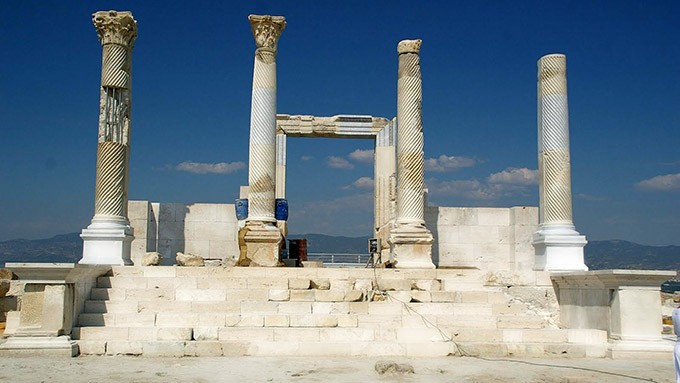
Laodicea or Laodikeia, situated at the borders of Eskihisar, Goncali, and Bozburun villages, lies 6 km north of Denizli. Nestled in the fertile plains of the Lycos River, the city is positioned on a high plateau, flanked by the rivers Lycos to the northeast, Kapros to the southeast, and Asopos to the northwest. Founded by the Seleucid king Antiochus the Second in honor of his wife Laodike in the 3rd century BC, Laodicea became part of the Roman Empire around 130-129 BC.
Despite enduring numerous earthquakes and subsequent reconstructions, the city was ultimately abandoned after a severe earthquake during the reign of Emperor Focas (602-610 CE), with its citizens relocating to Denizli. Laodicea was among the seven churches mentioned in the Book of Revelation, attaining metropolitan status during the Byzantine era.
The city thrived on trade due to its strategic position at the crossroads of commercial routes, with textiles being a major trade commodity. Laodicea was laid out in a Hippodamic or Grilled plan, characterized by streets intersecting at right angles or running parallel to each other, covering an area of approximately five square kilometers. Notable remnants include the largest ancient stadium in Anatolia (measuring 280*70 m), two theaters, four bathhouse complexes, four agoras, five fountains, two monumental portals, a council house, temples, churches, and a monumental street. The city is encircled by graves on all four sides.
Syria Gate : Located just south of the modern entrance to the site, the Syria Gate features three archways constructed with cut travertine blocks in the Doric order during the reign of Emperor Domitian (84-85 BC), contemporaneous with the Frontinus Gate in Hierapolis.
East Baths : Situated on the north side of the Syria street, the east baths date to the Roman period, featuring a central layout constructed with piers, arches, and vaults, comprising changing halls, cold halls, lukewarm halls, and hot halls.
East Byzantine Gate: Found on the Syria Street, the East Byzantine Gate was constructed in 395 CE under Emperors Theodosius and Arcadius, featuring square-shaped towers flanking the gate, with two passageways, one for horse carriages and the other for pedestrians.
East Byzantine Fountain : Adjacent to the North tower of the East Byzantine gate, this rectangular fountain was built in the early fifth century CE, supplying water to those residing outside the city walls or arriving from outside.
The Syria Street : Extending 900 meters from the city center to the Syria Gate on the east, this main street underwent various construction phases following the earthquake of 494 CE, flanked by colonnades and featuring shops, House A, Temple A, Fountain A, Propylon, and the Central Agora.
House A : Located in a side alley leading north from the Syria Street, House A comprises an inner courtyard and interconnected rooms, serving as both a house and a workshop over three phases of use.
Street Water Distribution Center : Situated at the corner of a side alley leading north from the Syria Street, this center was utilized following the city’s shrinkage post the earthquake in 494 CE, featuring a small pool and distribution lines for water supply.
Temple A : Positioned at the northern end of a rectangular courtyard off the Syria Street, Temple A is a prostyle structure with four spirally fluted columns at the front, built in the Antonine period and later repurposed as an archive in the fourth century CE.
Nymphaeum A: Also known as the Fountain of Septimus Severus, Nymphaeum A is a monumental fountain located on the north side of the Syria Street, featuring a rectangular pool and a two-story construction adorned with marble, dedicated to Emperor Septimus Severus (198-211 CE).
Central Baths : Situated south of the Central Agora, the Central Baths encompass caldarium, tepidarium, frigidarium, and apodyterium, dating to the Roman Imperial period and serving various functions until the city’s abandonment in the early seventh century CE.
Propylon 1 : The monumental portal Propylon 1, located opposite the west corner of the Central Agora on the Syria Street, was damaged in earthquakes during the reign of Diocletian but remained in use until the seventh century CE.
Caracalla Nymphaeum: Built at the junction of the Syria Street and the Stadium Street, this monumental fountain was dedicated to Emperor Caracalla (211-217 CE) during his visit to Laodikeia.
The Western Theatre: Constructed entirely in earth in the Hellenistic period, the Western Theatre served as a quarry after the seventh century CE.
Corinthian Temple and North Basilica: Facing the Lycos plains, the North Basilica and Corinthian Temple stand between the two theaters, possibly built in the fifth century CE and utilized until the beginning of the seventh century.
The Ephesus Gate: This well-preserved gate from the Roman Imperial period resembles the Frontinus Gate in Hierapolis.
Northern Theatre: Built in the second century CE, the Northern Theatre boasted a capacity of about 12,000 people and served as a quarry after the seventh century CE.
West Bath: Located east of the Aphrodisias Street, the West Baths exemplify a cascading layout and feature frigidarium, tepidarium, and caldarium.
Boulaterion (Council House) : With a diameter of 35 m, the Bouleuterion dates to the reign of Emperor Hadrian and accommodated up to 600 people.
South Agora: Measuring 135-90 m, the South Agora was likely built in honor of Emperor Hadrian’s visit in 135 BC.
South Baths – Gymnasium Complex : Dedicated to Emperor Hadrian and his wife Sabina, this complex served as a twin bath and gymnasium.
Water Distribution Terminals: The two terminals supplied water to the city from the Baspinar spring in Denizli.
Stadium : Constructed entirely of marble, the stadium featured sphendones and could accommodate up to 25,000 people, dedicated to Emperor Titus.



